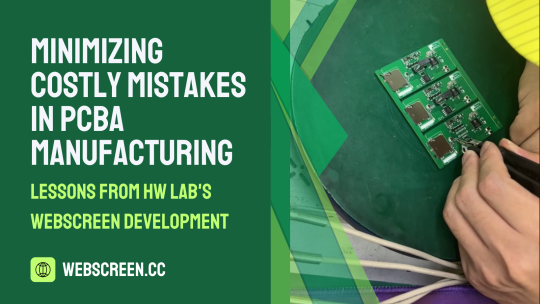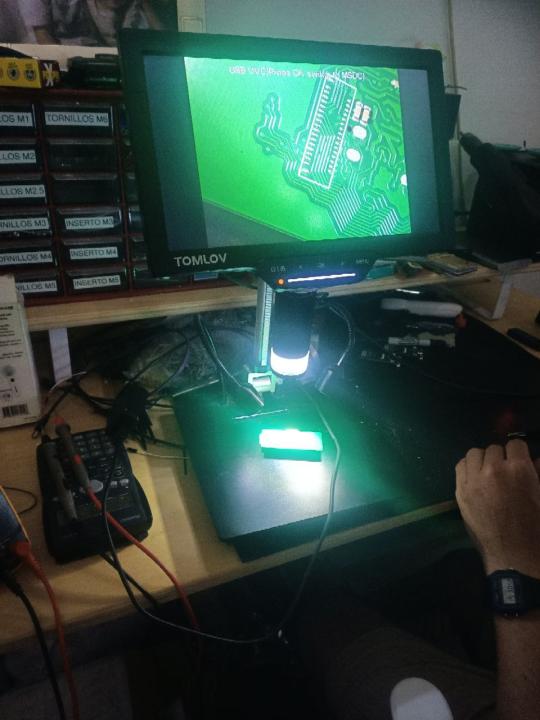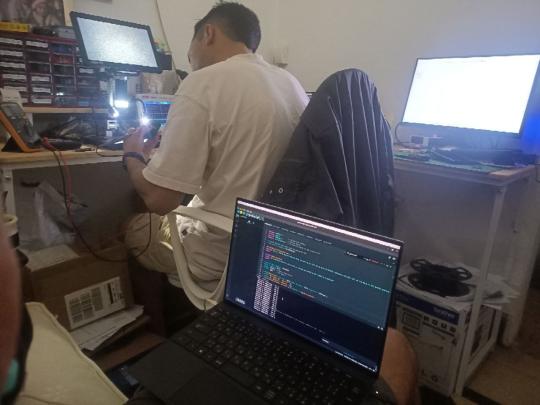
Minimizing Costly Mistakes in PCBA Manufacturing: Lessons from HW Lab's WebScreen Development
In the world of hardware development, mistakes in Printed Circuit Board Assembly (PCBA) can be both time-consuming and expensive. At HW Lab, we've navigated these challenges firsthand while developing our latest product, WebScreen. Drawing from our experiences, we'd like to share strategies we've employed to minimize costly errors in PCBA manufacturing. From meticulous diagram reviews to rigorous testing protocols, these practices have been instrumental in ensuring the quality and reliability of our products.
1. Thoroughly Reviewing Schematics and Diagrams
Before a single component is soldered, it's crucial to ensure that your schematics and PCB layouts are error-free.
Cross-Functional Reviews: Involve both hardware and software engineers in reviewing the diagrams. Different perspectives can catch issues that might be overlooked by a single discipline.
Checklists: Utilize comprehensive checklists to verify component values, signal paths, power requirements, and grounding schemes.
Design Rule Checks (DRC): Leverage PCB design software tools that offer automated DRC to identify potential issues like short circuits or impedance mismatches.
Our Experience: During WebScreen's development, we conducted multiple rounds of schematic reviews. This collaborative effort between our teams in Japan and Argentina helped us catch a misaligned voltage regulator specification that could have led to significant delays.
2. Starting with Small Batch Orders for Testing
Ordering a small number of PCBs for initial testing can save you from committing to a large batch of faulty boards.
Prototype Runs: Begin with a prototype batch to validate the design and assembly process.
Iterative Testing: Use these prototypes to test and refine before scaling up production.
Cost-Benefit Analysis: While unit costs are higher for small batches, the potential savings from avoiding mass-production errors are substantial.
Our Experience: We ordered a limited run of WebScreen PCBs from our manufacturing partners in Shenzhen. This allowed us to test the boards thoroughly and identify a misplaced component affecting the Wi-Fi module before it became a costly mistake in a larger production run.

3. Utilizing Precision Testing Tools
Investing in high-quality testing equipment is essential for identifying subtle issues that could compromise your product's performance.
Oscilloscopes and Logic Analyzers: Essential for analyzing signal integrity and timing issues.
Network Analyzers: Useful for testing RF components like Wi-Fi and Bluetooth modules.
Environmental Chambers: To test how the PCB performs under different temperature and humidity conditions.
Our Experience: We used precision tools to test WebScreen's BLE and Wi-Fi capabilities. This helped us detect an antenna tuning issue that could have degraded performance in real-world conditions.
4. Implementing Rigorous Functional and Unit Testing
Testing each component and subsystem individually ensures that all parts of your PCB function correctly before full system integration.
Unit Tests: Write test cases for individual components like microcontrollers, memory units, and sensors.
Functional Tests: Validate that each subsystem performs its intended function within specified parameters.
Automated Testing Scripts: Develop scripts to automate repetitive testing tasks, increasing efficiency and consistency.
Our Experience: For WebScreen, we developed a suite of automated tests to check SD memory access, screen connectivity, and peripheral interfaces. This not only sped up our testing process but also improved the reliability of our results.

5. Collaborating Closely with Manufacturing Partners
Effective communication with your manufacturing partners can prevent misunderstandings that lead to errors.
Clear Documentation: Provide detailed manufacturing instructions and clarify any non-standard requirements.
Regular Updates: Maintain open lines of communication to receive timely updates and address issues promptly.
Partner Feedback: Encourage your manufacturers to provide feedback on potential design improvements or manufacturing efficiencies.
Our Experience: Our close collaboration with suppliers in Shenzhen was pivotal. Their proactive communication helped us catch a potential soldering issue due to a non-standard pad layout on our PCB.
6. Performing Design for Manufacturability (DFM) Analysis
DFM ensures that your PCB design is optimized for manufacturing, reducing the risk of production errors.
Standard Components: Use commonly available components to avoid supply issues and reduce costs.
Simplify Design: Avoid overly complex designs that increase the likelihood of manufacturing errors.
Tolerance Considerations: Account for manufacturing tolerances in your design specifications.
Our Experience: We conducted DFM analysis on WebScreen's design, which led us to adjust the spacing of certain components. This small change improved assembly yield and reduced the chance of shorts.
7. Planning for Environmental and Stress Testing
Subjecting your PCBs to environmental and stress tests can reveal issues that only appear under certain conditions.
Thermal Cycling: Test how temperature fluctuations affect your PCB's performance.
Vibration Testing: Ensure that mechanical stresses don't cause component failures.
EMI/EMC Testing: Verify that your PCB doesn't emit unwanted electromagnetic interference and is immune to external sources.
Our Experience: Environmental testing revealed that certain components on the WebScreen PCB were susceptible to heat-related drift. We addressed this by selecting components with better thermal stability.
8. Incorporating Feedback Loops
Establish mechanisms to incorporate testing and field feedback back into your design process.
Beta Testing: Release prototypes to a select group of users to gain real-world usage data.
Issue Tracking Systems: Use software tools to track identified issues and their resolutions.
Continuous Improvement: Regularly review feedback and data to inform design enhancements.
Our Experience: Feedback from early WebScreen testers highlighted occasional screen flickering. Investigating this led us to improve the power regulation circuitry, enhancing overall product stability.
9. Leveraging Simulation Tools
Before physical prototypes, simulation tools can predict how your PCB will perform.
Signal Integrity Simulations: Analyze potential issues with high-speed signals.
Thermal Simulations: Predict hotspots and thermal distribution across your PCB.
Circuit Simulators: Test how different components will interact within your circuit.
Our Experience: Simulating WebScreen's power delivery network helped us optimize the placement of decoupling capacitors, improving voltage stability across the board.
10. Documenting Everything
Comprehensive documentation ensures that knowledge is preserved and accessible for future reference.
Revision Histories: Keep detailed records of all design changes and the reasons behind them.
Testing Protocols: Document testing procedures and results meticulously.
Manufacturing Records: Maintain records of manufacturing runs, including any issues encountered and how they were resolved.
Our Experience: Detailed documentation during WebScreen's development allowed new team members to get up to speed quickly and reduced the risk of repeating past mistakes.
Conclusion
Minimizing costly mistakes in PCBA manufacturing is a multifaceted challenge that requires diligence, collaboration, and strategic planning. By implementing the strategies above, we've been able to reduce errors, save costs, and deliver a reliable product with WebScreen.
Our experiences underscore the importance of:
Early Detection: Catching issues early in the design phase where they are less expensive to fix.
Collaboration: Working closely with manufacturing partners and within your team to leverage collective expertise.
Continuous Improvement: Using each prototype and test as an opportunity to refine and enhance the product.
By sharing these insights, we hope to assist other hardware developers in navigating the complexities of PCBA manufacturing, ultimately leading to better products and more efficient development cycles.


